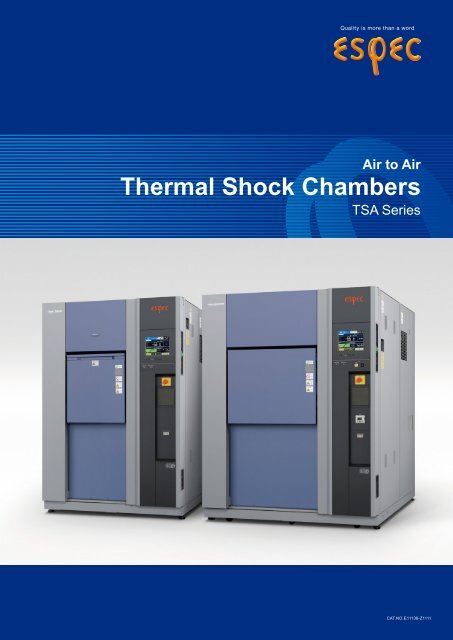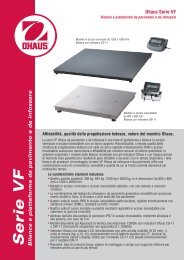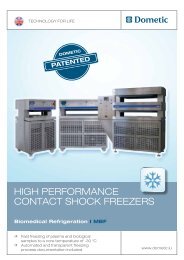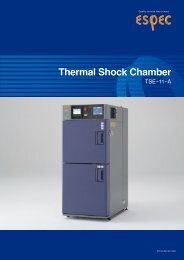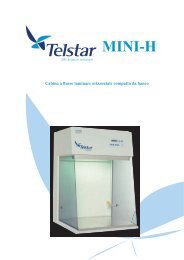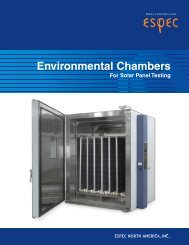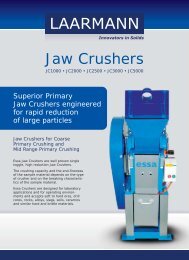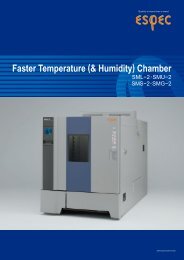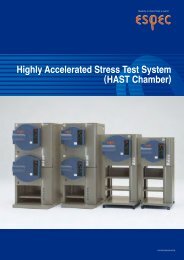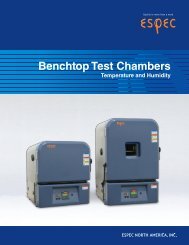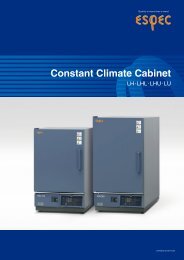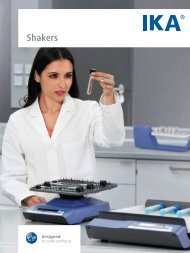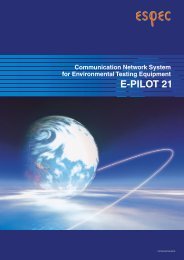Thermal Shock Chambers - MB Electronique
Thermal Shock Chambers - MB Electronique
Thermal Shock Chambers - MB Electronique
- No tags were found...
Create successful ePaper yourself
Turn your PDF publications into a flip-book with our unique Google optimized e-Paper software.
Air to Air<strong>Thermal</strong> <strong>Shock</strong> <strong>Chambers</strong>TSA SeriesCAT.NO.E11138-Z1111
Energy savings and high reliabilityin the new seriesNew series thermal shock chambers have been developed to improve our existing models, interms of reliability, but also in terms of efficiency.Compared to the previous TSA series, the power consumption has been reduced of 35-50%.Energy saving is achieved thanks to the Eco operation mode; the instrumentation automaticallyadjusts pre-cooling and pre-heating periods and runs operations with just the necessary energy.Improvements in chamber’s reliability. Particular emphasis was placed on removing unnecessaryloads and stresses from the refrigeration system, refrigerators themselves,and the refrigeration circuit.Various measures have been implemented to anticipate troubles and enhance chamber’s reliability.<strong>Thermal</strong> stress on the specimen can differ according to its position; therefore we have furtherminimized variations in the temperature attainment time that influences test results. Finally, weare accurately responding to the needs of these days by adapting our safety designs to globalrequirements, thanks to our experience of the market.TSA–72TSA–1021
TSA–202TSA–302* Equipped with options.2
CharacteristicsMaximum 50% reduction in power consumption with Eco operationmode and new refrigerator control system● Power consumption amount comparison example(Power consumption amount per cycle by comparing ESPEC chambers)00TSA−72ES−APrevious modelTSA−102ES−WTSA−202ES−WTSA−72EH−W● Temperature changes under Eco operation (example)Operation setup5.0 10.05.0 10.0Test conditions (Two-zone)High-temp. exposure : +125°CLow-temp. exposure : –40°CSpecimen: Plastic molded ICs: 5 kg (72, 102)10 kg (202)Hot chamberPrevious modelHigh-temp.exposure–43%–40%–50%–35%15.015.0High-temp.exposurePower consumptionamount (kWh)Power consumptionamount (kWh)Exposure time :30 min.Temperature recovery time : Within 5 min.Eco operationNormal operationStop operation Pre-heating operation Stop operation Pre-heatingoperationTest areatemperatureAutomatic setting ofpre-cooling and pre-heatingin energy saving, Ecooperation mode (Patent pending)The new series incorporates an algorithmthat calculates the minimum operationtime for pre-cooling and pre-heating byconstantly measuring the amount of heatrequired for these processes in ecooperation mode. This feature can furtherreduce power consumption and removethe inaccuracies and hassles caused byadjustments based on preliminaryexperiments. Tests operation achieves bothenergy savings and reproducibility/reliability.Parallel refrigerator controlsystem for energy-savingcontrol (Patent pending)To optimize further the power consumption,the chamber features a parallel controlsystem that connects two small refrigeratorsin parallel to the secondary side of therefrigeration circuit. The chamber canoperate at the optimal refrigeration capacitybased on the controlled temperature, byswitching operation between tworefrigerators simultaneously or a singlerefrigerator. At stable low-temperatureexposures, power consumption is alsoreduced by limiting refrigeration capacitywith an electronic expansion valve.Cold chamberLow-temp.exposureLow-temp.exposureStop operation Pre-cooling operation Stop operation Pre-cooling operation● Parallel refrigerator control system power during Eco operation(compared to previous chamber)Measuring used power(option: power meter)A wattmeter is provided as an option tomeasure the power consumed. It is alsopossible to halt a test by setting the stoptime. This function is useful for savingenergy.3emperature (°C)180160140120100806040Test area temperaturePower (kW)
CharacteristicsFurther reductions in power consumption with 500-hour continuous testsMinimizing defrosting burdenwith defrost-free operation(option: defrost-free operation)Until now testing was interrupted fordefrosting when necessary, but ESPEChas developed a unique structure that stopsfrost formation under low temperaturesby preventing the penetration of outsideair (defrost-free operation [patent 3514735]).Defrosting during cycle tests is thenunnecessary, thus reducing defrosting timeand the power consumed for thisoperation.1000 cycles continuousoperation(option: defrost-free operation)Defrost-free operation is provided as anoption so 500-hour continuous operationcan be performed without interruption (iftest conditions are set for 15-minuteexposure).● 1000 cycles (500-hour) test time comparison exampleEH TypeTest startDefrost operationDefrost-free operationDefrost 1hDefrost 1hDefrost 20 times24h 24h 24h 24hTest conditions (Two-zone, No test halt)High-temp. exposure : +150°C 15 min.Low-temp. exposure : −65°C 15 min.Outside conditions : +23°C/60% rhDefrost 1hDefrost 1h1000 cycles1000 cyclesTest time20-hour reductionPowerconsumption amount272 kWh reductionConsumed power amount to defrost once : 13.6 kWhConsumed power amount to defrost (20 times) : 272 kWhCooling water temp. : +25°CSpecimen : No specimen(Defrost 1 hour x 20 times)Vertical sliding doorEquipped with a vertical sliding structure,the door does not disrupt when insertingand removing specimens or whenconnecting cables to a specimen. The doorhas been lightened so that it can be easilyopened and closed.● 1000 cycles (500-hour) test time comparison exampleEH TypeTest startDefrost 20 times1000 cyclesEquipped with a round cable portThe chamber is equipped with a ø50 mmcable port so cables with bulky terminalconnectors and plugs can be easilyconnected. A flat cable port is also availableas an option.Combination with theESPEC’s evaluation systemThe ESPEC’s Conductor ResistanceEvaluation System (sold separately) cancontinuously measure the minute resistancein solder joints and the conductive sectionsof connectors in low temperature and hightemperature thermal cycle environments.It can be used connected to the thermalshock chamber.Defrost operationDefrost-free operationDefrost 1hDefrost 1hCable port ø50 mmDefrost 1h Test conditions (Two-zone, No test halt)High-temp. exposure : +150°C 15 min.Low-temp. exposure : −65°C 15 min.Outside conditions : +23°C/60% rhDefrost 1h1000 cyclesTest time20-hour reductionPower consumed amount to defrost once : 13.6 kWhPower consumed amount to defrost (20 times) : 272 kWhCooling water temp. : +25°CSpecimen : No specimenVertically sliding door(Defrost 1 hour x 20 times)Powerconsumption amount272 kWh reductionConductor Resistance Evaluation System connection (example)4
CharacteristicsThe pursuit of high performance, high accuracy, and ease of use.● Recovery rate & temperature uniformityTSA−202ES−W measurement example+123°C4.4 min.7.3 min.±1.0°Cor lowerHighly accurate temperaturerecoveryDampers with integrated rectifyingfunction minimize variation in exposureconditions due to specimen position withinthe test area. This reduces the overall testtime and shortens temperature recoverytime, especially during low-temperatureexposure. The uniformity in test conditionsbrought by this innovation also contributesto improved test reproducibility andreliability.–38°CTest conditionsHigh-temp. exposure: +125°C, 30 min.Pre-heating temperature: +145°CLow-temp. exposure: –40°C, 30 min.Pre-cooling temperature: –55°C±1.5°C or lowerSpecimen: Printed circuit boards 150 pcs.Measuring points: 10Even more reliable tests(option: specimen temperature control*)A single temperature sensor is attachedto the specimen in the test area and thechamber is controlled by this temperaturemeasurement.Even more accurate tests can be run bycontrolling the chamber with the specimentemperature because the air temperatureand the temperature inside the specimenare different when attaining the temperaturesetting. The chamber is controlled so thatthe specimen temperature achieves thetemperature setting even quicker and moreaccurately.* Cannot be combined with Eco operationmode.Test areaSpecimen temperaturemonitoring(option: specimen temperature monitorwith trigger function)Two temperature sensors are attached tothe specimen in the test area to measurethe specimen's temperature.This option features a trigger function thatswitches to the exposure test after the twotemperatures reach the temperature setting,so even more precise thermal tests can berun.* Cannot be combined with Eco operationmode.5
CharacteristicsImproved reliability. Use our chambers safely and with peace of mind formany years to come.The newly developedrefrigeration system improvesthe refrigeration circuit reliabilityTo reduce thermal stress on the refrigeratorsand prevent corrosion in the circuit, thematerial and thickness of piping has beenchanged and this prevents refrigerant leaks.Through other countless detailedimprovements, the reliability of therefrigeration circuit has been increasedand it can be used safely for many yearsto come.● Refrigeration circuit(Parallel refrigeration system: patent pending)EvaporatorAccumulatorELVInter. INJCompressorCascadecondenserAccumulatorEVInter. INJCompressorCondenserDrainageWaterGlobal safety designWe deliver chambers that conform tointernational safety standards.Our chambers conform to ISO riskassessment as well as global safety designelectrical safety standards such as CEmarking and EMC directive.· ISO 12100: 2010· ISO 60204-1· IEC 610000-6*EN standardization is standardizedby the European UnionCompressor6
InstrumentationColor LCD interactive touch-screen systemOperation and settings simplified by theuse of a touch-screen LCD display(instructions displayed on-screen). At-aglanceconfirmation of test patterns, testarea temperatures, temperature cycles,upstream / downstream control, and trendgraphs display.●Test settings●Test detail monitorEnhanced test halt preset function(Patent pending)It is now possible to program tests to haltafter cycle or exposure completion. Sixcycle counters are also built-in to theinstrumentation so a test halt preset canbe programmed for each counter. Thefunction can be used to multiple ends suchas removing specimens to the chamber.Test continuity selection functionWhen the test is halted, select to resumethe test from the point where it was haltedor to start the test from the beginning.SettingInteractive key input by touch panelDisplayTFT Color LCD (10.4–inch)● Halt preset function● Service guideTemperaturecontrolfunctionTest area: exposure temp.Hot chamber: pre-heating temp.Cold chamber: pre-cooling/defrosting temp.Temperature controls are PID controlSettingresolutionTemperature: 1°CTime: 1 min.(Remaining time display is 1 sec.)InputThermocouple type T (copper/copper-nickel)Setting rangeTime: 0 to 99 hours 59 minutesTest cycle: 1 to 9999 cycles7● AlarmTest patternsAuxiliaryfunctionsRAM (freely register): 40 patterns max.(Registration possible)ROM (built-in fixed): 20 standard test patternsRegistered• Timer preset • Program memory• Test continuity selection • Automatic power• Overheat/overcoolshut-offprotection• Programmed time• Up-stream/down-streamdisplaysensor selection • Cycle counter• Stable time control • Test halt preset• Exposure time reduction • Completion mode• Eco operationselection• Power failure recovery• Trend graphoperation selection • Alarm history display• Automatic defrost • Sensor calibration• Temperature recovery • RS–485 communicationtime setting• Accumulated time• Pre-conditioning/posttreatment• Dry operation
TEST STANDARD AND COMPATIBLE MODELSTest standardMIL–STD–883H(Method No. 1010.8)ABHigh temp.+85°C+100Exposure temperatureAmbienttemp.Low temp.0Exposure timeHigh/low temp.Ambienttemp.Temperaturerecovery timeNumber oftest cyclesTest startingpoint–55°C –10+125°C+150—10 min. or longer —Model *1EL type ES type EH typeWorst caseC +150°C+150 specimenLow temp. — —Minimum—temp.or10D +200°C+15WithinHigh temp.0— — —–65°C015 min.–10E +300°C+150— — ——F+15+175°C 0— —MIL–STD–202G(Method No. 107G)ABCDEF+85°C+30*20–55°C *2–3*3+125°C+3Differs according to0— *2specimen weight+200°C+528 g or lower,5 cycles0 Up–stream— —+1015 min. or 30 min. Max25 cycles+25°C –5 28 g to 136 g, 30 min.WithinLow temp.05 min.136 g to 1.36 kg, 60 min.5 min. 50 cycles+350°C+5–65°C 0 –5 100 cycles— — —1.36 to 13.6 kg, 120 min.+500°C+50 13.6 to 136 kg, 240 min.— — —+3+150°C 0— *2IEC 60068–2–14(JIS C 60068–2–14)+70°C ±2+85°C ±2+100°C ±2+125°C ±2+155°C ±2+175°C ±2+200°C ±2—–5°C ±3–10°C ±3–25°C ±3–40°C ±3–55°C ±3–65°C ±33 hrs.2 hrs.1 hrs.If not specified:3 hrs.—Exposuretimewithin 10%If notspecified5 cyclesLow temp. *2 *2JASO D 014–4+65°C ±2+70°C ±2+80°C ±2+85°C ±2+90°C ±2+100°C ±2+110°C ±2+120°C ±2+125°C ±2+130°C ±2+140°C ±2+150°C ±2+155°C ±2+160°C ±2—–20°C ±3–40°C ±320 min.40 min.60 min.90 min.—Exposuretimewithin 10%If notspecified5 cyclesLow temp. *2 *2EIAJ ED–2531A+60°C ±2+65°C ±2+70°C ±2+75°C ±2+80°C ±2+85°C ±2+90°C ±2+95°C ±2+100°C ±2Ambienttemp.0°C ±3–5°C ±3–10°C ±3–15°C ±3–20°C ±3–25°C ±3–30°C ±3–35°C ±3–40°C ±3–45°C ±3–50°C ±33 hrs.2 hrs.1 hrs.If not specified:3 hrs.2 to3 min.Exposuretimewithin 10%5 or10 cyclesLow temp.*2*3*1 The test results may not meet specifications depending on the quantity of specimens or the setting method.*2 Some models cannot be used depending on test conditions. For further information, please contact ESPEC.*3 Applicable when equipped with the ambient-temperature exposure option.8
CHA<strong>MB</strong>ER AND UTILITY REQUIREMENTSEL type ES type EH typeModel42EL−A 72EL−A 102EL−A 202EL−W 302EL−W 72ES−A 72ES−W 102ES−W 202ES−W 72EH−WAir-cooled Water-cooled Air-cooled Water-cooled Water-cooled200 VAC 49 A 70 A 70 A 110 A 120 A 78 A 120 A 112 APower supply220 VAC 47 A 70 A 70 A 110 A 120 A 75 A 120 A 108 A380/400/415 VAC 27 A 45 A 45 A 65 A 70 A 50 A 70 A 60 AAir 0.4 to 0.7 MPa (4 to 7 kgf/cm 2 )50 Hz — 95700 — 59700 95700 95700Condensation60 Hz — 96100 — 64800 104600 96100Cooling water supplyrate (at reference— 4.6 m 3 /h — 3.1 m 3 /h 4.6 m 3 /hwater temp.+32°C) *1*2Water pressure —0.2 to 0.5 MPa(2 to 5 kgf/cm 2 )—0.2 to 0.5 MPa(2 to 5 kgf/cm 2 )Piping connection size32 AOutside dimensionsmm (inch)W 1140H 1900D 1270W 1310H 1900D 1470W 1550H 1900D 1470W 1550H 1900D 1770W 1870H 1900D 1770W 1310H 1900D 1470W 1550H 1900D 1470W 1550H 1900D 1770W 1310H 1900D 1770*1 Maximum possible value during temperature recovery.*2 Rate depends on the cleanliness of the heat exchanger.9
EL TypeModel TSA–42EL–A TSA–72EL–A TSA–102EL–A TSA–202EL–W TSA–302EL–WSystemPerformance *1Cold chamber Hot chamber Test areaConstructionTemp. recoveryHigh temp. exposure range *2Low temp. exposure rangeTemp. fluctuation *3Pre-heat upper limitTemp. heat up time *4Pre-cool lower limitTemp. pull down time *4Recovery conditionsWithin 10 min.Two-zone test by means of damper switchingAmbient temp. +50 to +200°C (+122 to +392°F)–65 to 0°C (–85 to +32°F)±0.5°C (±0.9°F)+205°C (+401°F)Ambient temp. to +200°C (+392°F)Within 15 min.–75°C (–103°F)Ambient temp. to –70°C (–94°F)Within 70 min. Within 40 min. Within 60 min. Within 70 min. Within 40 min.Two-zone: High temp. exposure: +125°C 30 min. Low temp. exposure: –40°C 30 min.Power supply voltage: Rated voltage Sensor position: UpstreamSpecimen 3.5 kg(Plastic molded ICs, 2.5 kg,specimen basket/brackets 1 kg)Specimen 6.5 kg(Plastic molded ICs, 5 kg,specimen basket/brackets 1.5 kg)Specimen 7.5 kg(Plastic molded ICs, 5 kg,specimen basket/brackets 2.5 kg)Specimen 16 kg(Plastic molded ICs, 10 kg,specimen basket/brackets 6 kg)Specimen 17 kg(Plastic molded ICs, 10 kg,specimen basket/brackets 7 kg)Temp. recovery time *5 Within 15 min. Within 5 min. Within 10 min.Exterior materialCold-rolled rust proof treated steel plate (melamine resin coating)Interior materialStainless steel plateInsulationGlass wool, rigid polyurethane foamDoorManually operated sliding door with unlock buttonHeaterStripped wire heaterSystemMechanical cascade refrigeration systemAir-cooled condenserWater-cooled condenserCompressorHermetically sealedrotary compressorHermetically sealed scroll compressorExpansion mechanismElectronic expansion valve, otherRefrigeration unitRefrigerantHigh temp. side: R404ALow temp. side: R508AHigh temp. side: R404ALow temp. side: R23Plate fin cooler, cold accumulatorSirocco fanAir cylinderCoolerAir circulatorDamper driving unitTest area load resistance 30 kg (Equally distributed load) 50 kg (Equally distributed load)Inside dimensions (W x H x D mm/in.)240 x 460 x 370 410 x 460 x 370 650 x 460 x 370 650 x 460 x 670 970 x 460 x 670(9.45 x 18.11 x 14.57) (16.14 x 18.11 x 14.57) (25.59 x 18.11 x 14.57) (25.59 x 18.11 x 26.38) (38.19 x 18.11 x 26.38)Outside dimensions (W x H x D mm/in.) *6 1140 x 1900 x 1270 1310 x 1900 x 1470 1550 x 1900 x 1470 1550 x 1900 x 1770 1870 x 1900 x 1770(44.88 x 74.80 x 50) (51.57 x 74.80 x 57.87) (61.02 x 74.80 x 57.87) (61.02 x 74.80 x 69.69) (73.62 x 74.80 x 69.69)Weight Approx. 730 kg Approx. 900 kg Approx. 1050 kg Approx. 1200 kg Approx. 1420 kgAllowable ambient conditions0 to 40°C (+32 to +104°F)200 VAC 3ø 50/60 Hz 49 A 70 A 70 A 110 A 120 APower supply 220 VAC 3ø 60 Hz 47 A 70 A 70 A 110 A 120 A380/400/415 VAC 3ø 50 Hz 27 A 45 A 45 A 65 A 70 ANoise level *7 65 dB 62 dB 65 dBAir supply 0.4 to 0.7 MPa (4 to 7 kgf/cm 2 )Cooling water supply pressure — 0.2 to 0.5 MPa (2 to 5 kgf/cm 2 )Cooling water supply rate *8 — 4.6 m 3 /h (ref. water temp.: +32°C)Operating cooling water temp. range — +5 to +38°C (+41 to +100°F)Utility requirements*1 Air-cooled: Ambient temperature of +23°CWater-cooled: Ambient temperature of +10 to +30°C and a cooling watertemperature of +25°C*2 If the high-temperature exposure range lower limit +60°C is required,select the “ambient-temperature exposure” option*3 Performance shown above conforms to IEC 60068-3-5: 2001*4 Temperature heat-up/pull-down time are applicable only during independentchamber operation*5 Tolerance in temperature recovery time is based on IEC60068-2-1 andIEC60068-2-2*6 Excluding protrusions*7 Noise level was measured in an anechoic room at a height of 1.2 m from thefloor and a distance of 1 m from the chamber front panel (ISO 1996-1:2003A-weighted sound pressure level). Actual noise emissions may increasebecause of surrounding reverberations in the place of installation, therefore usecaution in selecting a place of use.*8 Rate depends on the cleanliness of the heat exchanger10
ES Type11Model TSA–72ES–A/W TSA–102ES–W TSA–202ES–WSystemPerformance *1Cold chamber Hot chamber Test areaConstructionTemp. recoveryHigh temp. exposure rangeLow temp. exposure rangeTemp. fluctuation *2Pre-heat upper limitTemp. heat up time *3Pre-cool lower limitTemp. pull down time *3Recovery conditions*1 Ambient temperature of +23°C and a cooling water temperature of +25°C*2 Performance shown above conforms to IEC 60068-3-5: 2001*3 Temperature heat-up/pull-down time are applicable only during independentchamber operation*4 Tolerance in temperature recovery time based on IEC60068-2-1 and IEC60068-2-2*5 Excluding protrusionsTwo-zone or three-zone test by means of damper switching+60 to +200°C (+140 to +392°F)–70 to 0°C (–94 to +32°F)±0.5°C (±0.9°F)+205°C (+401°F)Ambient temp. to +200°C (+392°F) within 15 min.–75°C (–103°F)Ambient temp. to –75°C (–103°F)Within 40 min. Within 50 min. Within 45 min.· Three-zoneHigh-temp. exposure: +150°C, 30 min.Ambient-temperature exposure: Ambient temperature, 5 min.Low-temp. exposure: –65°C, 30 min.· Power supply voltage: Rated voltage· Sensor position: Upstream· Specimen 6.5 kgPlastic molded ICs: 5 kgSpecimen basket/brackets: 1.5 kg· Specimen 7.5 kgPlastic molded ICs: 5 kgSpecimen basket/brackets: 2.5 kg· Three-zoneHigh-temp. exposure:+150°C, 30 min.Ambient-temperature exposure:Ambient temperature, 10 min.Low-temp. exposure:–65°C, 30 min.· Power supply voltage: Rated voltage· Sensor position: Upstream· Specimen 26 kgPlastic molded ICs: 20 kgSpecimen basket/brackets: 6 kgTemp. recovery time *4 Within 5 min. Within 10 min.Exterior materialInterior materialInsulationDoorHeaterRefrigeration unitCoolerSystemCompressorExpansion mechanismRefrigerantAir circulatorDamper driving unitCold rolled rust proof treated steel plate (melamine resin coating)Stainless steel plateGlass wool/rigid polyurethane foamManually operated sliding door with unlock buttonStripped wire heaterMechanical cascade refrigeration systemAir-cooled condenser orWater-cooled condenserwater-cooled condenserHermetically sealed scroll compressorElectronic expansion valve, otherHigh temp. side: R404A Low temp. side: R23Plate fin cooler, cold accumulatorSirocco fanAir cylinderTest area load resistance 30 kg (Equally distributed load) 50 kg (Equally distributed load)Inside dimensions (W x H x D mm/in.) 410 x 460 x 370 (16.14 x 18.11 x 14.57) 650 x 460 x 370 (25.59 x 18.11 x 14.57) 650 x 460 x 670 (25.59 x 18.11 x 26.38)Outside dimensions (W x H x D mm/in.) *5 1310 x 1900 x 1470 (51.57 x 74.80 x 57.87) 1550 x 1900 x 1470 (61.02 x 74.80 x 57.87) 1550 x 1900 x 1770 (61.02 x 74.80 x 69.69)Weight Approx. 1050 kg Approx. 1150 kg Approx. 1400 kgUtility requirementsAllowable ambient conditionsPower supplyNoise level *60 to +40°C (+32 to +104°F)200 VAC 3ø 50/60 Hz 78 A 120 A220 VAC 3ø 60 Hz 75 A 120 A380/400/415 VAC 3ø 50 Hz 50 A 70 A65 dB or lowerAir supply 0.4 to 0.7 MPa (4 to 7 kgf/cm 2 )Cooling water supply pressure 0.2 to 0.5 MPa (2 to 5 kgf/cm 2 ) (water-cooled specification) 0.2 to 0.5 MPa (2 to 5 kgf/cm 2 )Cooling water supply rate *7 3.1 m 3 /h (reference water temp: +32°C) (water-cooled specification) 4.6 m 3 /h (reference water temp: +32°C)Operating cooling water temp. range+5 to +38°C (water-cooled specification)*6 Noise level was measured in an anechoic room at a height of 1.2 m from thefloor and a distance of 1 m from the chamber front panel (ISO 1996-1:2003A-weighted sound pressure level). Actual noise emissions may increasebecause of surrounding reverberations in the place of installation, thereforeuse caution in selecting a place of use.*7 Rate depends on the cleanliness of the heat exchanger
EH TypeModelSystemPerformance *1Cold chamber Hot chamber Test areaConstructionTemp. recoveryHigh temp. exposure range *2Low temp. exposure rangeTemp. fluctuation *3Pre-heat upper limitTemp. heat up time *4Pre-cool lower limitTemp. pull down time *4Recovery conditionsTemp. recovery time *5Exterior materialInterior materialInsulationDoorHeaterRefrigeration unitCoolerSystemCompressorExpansion mechanismRefrigerantAir circulatorDamper driving unitTest area load resistanceTSA–72EH–WTwo-zone or three-zone test by means of damper switching+60 to +200°C (+140 to +392°F)–70 to 0°C (–94 to +32°F)±0.5°C (±0.9°F)+205°C (+401°F)Ambient temp. to +200°C (+392°F) within 15 min.–77°C (–106.6°F)Ambient temp. to –75°C (–103°F) within 50 min.· Two-zoneHigh-temp. exposure: +150°C, 15 min.Low-temp. exposure: –65°C, 15 min.· Power supply voltage: Rated voltage· Sensor position: Downstream· Specimen 5 kgPlastic molded ICs: 3.5 kgSpecimen basket/brackets: 1.5 kgWithin 5 min.Cold rolled rust proof treated steel plate (melamine resin coating)Stainless steel plateGlass wool/rigid polyurethane foamManually operated sliding door with unlock buttonStripped wire heaterMechanical cascade refrigeration systemWater-cooled condenserHermetically sealed scroll compressorElectronic expansion valve, otherHigh temp. side: R404A Low temp. side: R23Plate fin cooler, cold accumulatorSirocco fanAir cylinder30 kg (Equally distributed load)Inside dimensions (W x H x D mm/in.) 410 x 460 x 370 (16.14 x 18.11 x 14.57)Outside dimensions (W x H x D mm/in.) *6 1310 x 1900 x 1770 (51.57 x 74.80 x 69.68)WeightUtility requirementsAllowable ambient conditionsPower supplyNoise level *7Approx. 1150 kg0 to +40°C (+32 to +104°F)200 VAC 3ø 50/60 Hz 112 A220 VAC 3ø 60 Hz 108 A380/400/415 VAC 3ø 50 Hz 60 A65 dB or lowerAir supply 0.4 to 0.7 MPa (4 to 7 kgf/cm 2 )Cooling water supply pressure 0.2 to 0.5 MPa (2 to 5 kgf/cm 2 )Cooling water supply rate *8Operating cooling water temp. range*1 Ambient temperature of +23°C and a cooling water temperature of +25°C*2 During pre-heating, prevention operation for temperature heat-up may be worked.*3 Performance shown above conforms to IEC 60068-3-5: 2001*4 Temperature heat-up/pull-down time are applicable only during independentchamber operation*5 Tolerance in temperature recovery time based on IEC60068-2-1 and IEC60068-2-2*6 Excluding protrusions4.6 m 3 /h (reference water temp: +32°C)+5 to +38°C*7 Noise level was measured in an anechoic room at a height of 1.2 m from thefloor and a distance of 1 m from the chamber front panel (ISO 1996-1:2003A-weighted sound pressure level). Actual noise emissions may increasebecause of surrounding reverberations in the place of installation, thereforeuse caution in selecting a place of use.*8 Rate depends on the cleanliness of the heat exchanger12
SAFETY DEVICES• Leakage breaker (200, 220V AC specifications)• Circuit breaker (380, 400/415V AC CE specifications)• Electrical compartment door switch• Test area door switch• Hot chamber overheat protection switch• Cold chamber overheat protection switch• Hot chamber overheat protector (controller)• Cold chamber overheat protector (controller)• Air circulator overload relay• Refrigerator high/low pressure switches• Compressor built-in protector (except TSA–42EL)• Compressor temperature switch• <strong>Thermal</strong> relay for compressor (TSA–42EL only)MODELTSA –Condensation systemA : Air-cooled typeW : Water-cooled typePerformance classificationE LESEHTest area capacity42 : 40L72 : 70L102 : 110L202 : 200L302 : 300L• Water suspension relay (water-cooled specification only)• Air circulator thermal relay• Motor reverse prevention relay• Air pressure switch• Fuse• Cooling tower interlock terminal (water-cooled specification only)• Compressor circuit breaker• Heater circuit breaker• Test area overheat/overcool protector (controller)• Test area overheat/overcool protector (option)• Air purge valve• Specimen power supply control terminalACCESSORIES• Specimen basket (18-8 Cr-Ni stainless steel/5 mesh metal basket)TSA–42(W230 x H40 x D356 mm/load capacity 2.5 kg) ······················ 2TSA–72(W400 x H40 x D356 mm/load capacity 5 kg) ························· 2TSA–102(W640 x H40 x D356 mm/load capacity 5 kg) ························· 2TSA–202(W640 x H40 x D656 mm/load capacity 17 kg) ······················· 2TSA–302(W960 x H40 x D656 mm/load capacity 17 kg) ······················· 2FITTINGS• Cable port ø50 mm (left side) ··················································1• Specimen power supply control terminal ································1• Time signals ·············································································2DANGER● Do not use explosive substances, flammablesubstances, or substances that contain thosesubstances as a specimen under any circumstances.Danger: Risk of explosion and fire.● Do not put corrosive substances inside the testarea. If corrosive substances are generated fromthe specimen, the life of the product's corrosionresistance will decrease dramatically due, inparticular, to corrosion of stainless steel, resin,and silicone.● Do not use living organisms or items that exceed theallowable heat load as a specimen.• Shelf brackets(shelf attachment pitch 60 mm, adjustable in 7 levels) ···· 2 sets• Cartridge fuse5A ···························································································· 210A (non-standard specification) ··········································· 1• Cable port rubber plug ····························································· 1• Nipple (water-cooled specification only) ·································· 1• Strainer (water-cooled specification only) ······························· 1• Strainer element (water-cooled specification only) ················· 1• User’s manual ·········································································· 1CAUTIONAlways read the user's manual before using theproduct.13
DIMENSIONSTSA−72EL · 72ES(Unit: mm)235580 4954101900880 460560TSA−202EL · 202ES1900880 4605602351310820 495650670 37055013514708501770135155014
1000 cyclesTest conditions (Two-zone, No test halt)High-temp. exposure : +150°C 15 min.Low-temp. exposure : −65°C 15 min.Outside conditions : +23°C/60% rhConsumed power amount to defrost once : 13.6 kWhConsumed power amount to defrost (20 times) : 272 kWhCooling water temp. : +25°CSpecimen : No specimenOPTIONSDefrost-free operationFor two-zone tests, enables continuous testswithout requiring defrosting for up to 500hours max.ESPEC has developed a unique structure(patent: 3514735) that prevents the penetrationof outside air and uses recirculated air duringtesting to stop frosting on the low-temperatureside.This enables continuous tests up to 500 hours,so around 20 defrost cycles during this periodcan be eliminated.This option can reduce both the test time inthe amount of the defrosting time (approx.60 minutes each time) and the powerconsumption required for defrosting(13.6 kWh each time).● 1000 cycles (500-hour) test time comparison exampleEH TypeTest startDefrost operationDefrost-free operationDefrost 1hDefrost 1hDefrost 20 timesDefrost 1h Defrost 1h1000 cycles1000 cyclesTest time20-hour reduction(Defrost 1 hour x 20 times)Powerconsumption amount272 kWh reductionTest conditions (Two-zone, No test halt)High-temp. exposure : +150°C 15 min.Low-temp. exposure : −65°C 15 min.Outside conditions : +23°C/60% rhPower consumed amount to defrost once : 13.6 kWhPower consumed amount to defrost (20 times) : 272 kWhCooling water temp. : +25°CSpecimen : No specimen* The TSA−42EL−A, 72EL−A and 102EL−A have a300-mm protrusion on the top.ModelNumber ofcyclesHigh-temp.exposure/timeLow-temp.exposure/timeOutsideconditionsCoolingwater temp.PowersupplyvoltageSensorpositionSpecimenTemp.recoverytimeTSA-42EL1.5 kgPlastic moldedICs 1.0 kgSpecimenbasket/shelfbrackets 0.5 kgTSA-72EL, ESTSA-102EL, ESTSA-202EL, ESMaximum 500 cycles (Maximum 500-hour)+125°C/30 min.−40°C/30 min.+23°C/60% rh+25°CRated voltageDownstream of specimen5.0 kgPlastic molded ICs 3.5 kgSpecimen basket/shelf brackets 1.5 kg10.0 kgPlastic molded ICs 7 kgSpecimen basket/shelf brackets 3 kgTSA-302EL TSA-72EHMaximum1000 cycles(Maximum500-hour)+150°C/15 min.−65°C/15 min.5.0 kgPlastic moldedICs 3.5 kgSpecimenbasket/shelfbrackets 1.5 kg( ) ( ) ( ) ( )Within15 min.Within 5 min.Within10 min.Within5 min.15
OPTIONSSpecimen temperature control● Measurement example TSA-72ES-ATemperature ()● Measurement example TSA-72ES-A Test conditionsHigh temp. exposure 150℃ 30 min. Specimen Plastic molded ICs (3.5 kg)Ambient temp. exposure 5 min. Specimen baskets 2nd and 6th level from topLow temp. exposure 65℃ 30 min. Control points 28-pin QFP (quad flat package) with sensor installed at center of 6th levelTemperature ()● Measurement example Test conditionsHigh temp. exposure Specimen 150℃ 30 min. Specimen Plastic molded ICs (3.5 kg)Ambient temp. temp. exposure (1) Start 5 min. of exposure Specimen baskets 2nd and 6th level from topLow temp. exposure65℃ 30 min. time count Control points 28-pin QFP (quad flat package) withsensor installed at center of 6th levelSpecimenSpecimen temperature temp. monitoring (2) with trigger functionStart of exposuretime countTemperature ()● Measurement example Temperature ()Specimentemp. (1)Start of exposuretime countSpecimentemp. (2)Start of exposuretime count A sensor is attached to the specimen to controlthe chamber based on the specimen temperature.The specimen temperature reaches and maintainsthe temperature setting as fast and accurately aspossible.(Cannot be combined with Eco operation mode.)· Number of measuring points: 1· Location: Chamber front, left-side panel· Accessory: Thermocouple type T (copper,copper-nickel) x1** 2 when simultaneously equipped with arecorderTwo sensors are attached to the specimen andthe temperature of the specimen displayedon the instrumentation is monitored. Theoption has a trigger function that switches tothe exposure test after the specimentemperatures reach the temperature setting,so even more precise tests can be run. It canalso record the temperatures of the specimenand the test area when connected to atemperature recorder.(Cannot be combined with Eco operationmode.)· Number of measuring points: 2· Location: Chamber front, left-side panel· Accessor y: Thermocouple type T(copper, copper-nickel) x2** 4 when simultaneously equipped with arecorder16
OPTIONSDual communication loggerConnect to a company network and the chamber statuscan be monitored on PCs and data can also bemanaged.Chamber failures information can be sent to PCs andcellular telephones via emails.Number of connected units• 1 unitFunctions• Monitoring function• Data management function• Communication functionRS-485LANDualcommunicationloggerTemperature(Thermo-couple)Intranet (company LAN)PCMail serverModelTMSMonitoring functionData managementfunctionsMonitor detailsAnalog inputMonitor screenSave dataSave intervalFile creationintervalDisplay saved dataDownload data· Operation state· Exposure state· Running cycle· Setting cycle· Test area temperature (Hot chamber, Pattern manager cold chamber, specimen temp.)· Test area display temperature Administration PC· Remaining step time· Number of alarms· Alarm number 1, 2· Trend graphUSBThermocouple, measured temperature resistance, voltage, contact, other temperature/humidity inputInterfaceconverterMonitoring one chamber on one browser screenSave data as binary data on a CF RS-485 card in the chamber RS-485From 1 sec. (display update interval asnd auto save interval)· Auto save interval· Memory time up (select from hour, day, week, month)Trend display, digital display with dedicated software, convert to Excel data, etc.Download saved data via the network16 max.Error notification· Send by email· Change the logger display color17
OPTIONSAmbient-temperature exposure (EL type only)Enables three-zone tests by adding adamper mechanism and an air circulator.· High temp. exposure range: +60 to 200°CRecorder terminalUsed to output the temperature within testarea, hot chamber, and cold chamber.ThermocoupleAt t a ched t o speci me n s t o measu respecimen temperature.· 2, 4, 6m· Thermocouple type T (Copper, copper-nickel)Exposure signal outputA signal is output via a contact switch whentest area temperature is within the userselectedrange. This signal can be used tocontrol peripheral instruments, likeapplying a voltage to specimens only duringhigh temperature exposure, or monitoringtest operation from a remote point.Preparation of a power cable, temperaturesensor, and conductor grounding wire foradditional installation in the future.Paperless recorderRecords the temperature of each section such asthe temperature inside the chamber.PL1S: Number of inputs: 1 (5 OFF*)Scan interval: 1 sec.PL3S: Number of inputs: 3 (3 OFF*)Scan interval: 1 sec.PL3L: Number of inputs: 3 (3 OFF*)Scan interval: 5 sec.PL4S: Number of inputs: 4 (2 OFF*)Scan interval: 1 sec.PL4L: Number of inputs: 4 (2 OFF*)Scan interval: 5 sec.PL5S: Number of inputs: 5 (1 OFF*)Scan interval: 1 sec.PL5L: Number of inputs: 5 (1 OFF*)Scan interval: 5 sec.· Temperature range: –100 to +220°C· External memoryCF memory card port(Includes a 256 <strong>MB</strong> CF card)USB memory port· Languages: English/Japanese, can be changed* Channels can be turned ONTemperature recorder (digital display)RK–61 1 penRK–63 3 pensRK–64 6 dots· Temperature range: –100 to +220°C· Effective recording chart width 100 mmRecorder wiringPreparation of a power cable, temperaturesensor, and conductor grounding wire foradditional installation in the future.Additional overheat protectorsAdditional preventive measures can betaken for excessive temperature rise in thechamber, in addition to the standardequipped overheat protector.External alarm terminalIf the safety device of the chamber isactivated, the external alarm terminal willnotify it to a remote point.Emergency stop pushbuttonStops the chamber immediately.Status indicator lightTo check the state of the chamber fromdistant locations.Total cycle counterIndicates cycle counts.· With reset function· Display range: 1 to 99999999Built-in air compressorSelect when there is no air supply source.Power meterAccumulates the amount of power the chamber uses.18
OPTIONSAutomatic doorAutomatic sliding door (vertical) operatedby single-touch button. Equipped with 2safety mechanisms: a photoelectric sensor,and a touch sensor. A door stop switch isalso set.* If you also need the emergency stopswitch, please contact us.Specimen basket/shelf bracketsEquivalent to standard accessory.· Material: stainless steel (5 mesh)Heavy-duty shelfUse to hold heavy specimens exceedingthe load capacity of the standard specimenbasket.· Load capacity: 30 kgPower cable5 m, 10 m* The chamber does not come with apower cable.Chamber dew trayAdditional cable portProvided in addition / replacement of thestandard cable port (left side)· φ50 mm roundPrevents water leaks from the chamberonto the floor.* The use of casters is recommended tofacilitate operation.Anchoring fixturesUsed to bolt the chamber to the floor.Interface· Computer interface: GPIB· Serial interface: RS–232C* Select one, instead of standard RS–485Flat cable portProvided in addition / replacement of thestandard cable port (left side).· 25 x 100 mm slotCable port rubber plugPrevents air leakage from the cable port.· φ50 mm for round port· For flat cablesCommunication cable· RS-485 cable: 5, 10 m· GPIB: 2, 4 m· RS-232C: 1.5, 3, 5 mPlug socketTo supply power to external equipment· 2 plug sockets· Rated capacity 100 VAC 3 A(Total capacity)Caster19Installed for mobility.· 6 casters (4 for TSA–42EL)· 4 levelling feet
<strong>Thermal</strong> <strong>Shock</strong> Chamber SeriesAir to Air <strong>Thermal</strong> <strong>Shock</strong> Chamber TSEA compact thermal shock chamber to handle thermalshock testing on small and limited volume specimens. Itsupports standardized testing with no auxiliary coolingand a two-zone (+150°C and –65°C) upstream airtemperature recovery time within 5 minutes. The TSEmodel provides the same performance as ESPEC’s largethermal shock chambers in a compact design.Model Temp. range Inside dimensions (mm)TSE–11High temp. side:+60 to +200°CLow temp. side:–65 to 0°CW320 x H148 x D230Air to Air <strong>Thermal</strong> <strong>Shock</strong> Chamber TSDA two-zone thermal shock chamber that complies withJapanese and global test standards such as MIL-STD-883and JIS C 0025.The TSD model can perform accurate testing by monitoringthe specimen temperature and starting the exposure timecount once it has reached the preset temperature or it canimmediately proceed to the next step in the sequence. Thetemperature recovery time between +150°C and –60°Cis just 15 minutes, which reduces the total test duration.Model Temp. range Inside dimensions (mm)TSD–100High temp. side:+60 to +200°CLow temp. side:–65 to 0°CW710 x H345 x D410Liquid to Liquid <strong>Thermal</strong> <strong>Shock</strong> Chamber TSBThe liquid to liquid thermal shock chamber is designed toapply higher stress to specimens.It has also greatly reduced required minimum installationspace. The highly airtight test areas and numerous newmechanisms reduce brine consumption, thus greatlyreducing running costs.It features easy operation thanks to the color LCDinteractive touch-screen system.ModelTSB–21TSB–51Temp. rangeHigh temp. chamber:+70 to +200°CLow temp. chamber:–65 to 0°CSpecimen basketdimensions (mm)W120 x H150 x D120W150 x H150 x D20020
Custom-made Equipment<strong>Thermal</strong> <strong>Shock</strong> Chamber 300°C specification<strong>Chambers</strong> that achieve high-temperature exposure of 300°C in thermal shock testing to find heat resistance at high temperatures.Model TSA–72ES (+300°C specification) TSD-100 (+300°C specification) TSE-11 (+300°C specification)Temp. rangeTemp. recovery performanceHigh temp. sideLarge capacity <strong>Thermal</strong> <strong>Shock</strong> Chamber+60 to +300°CLow temp. side –70 to 0°C –65 to 0°CHigh-temp.exposure/timeAmbient-temp.exposure/timeLow-temp.exposure/timeSensor position+300°C/30 min. +270°C/40 min. +300°C/30 min.Ambient temp./5 min. -–65°C/30 min. –40°C/40 min. –45°C/30 min.Upstream of specimenSpecimen Plastic molded ICs: 5 kg Plastic molded ICs: 5 kg Plastic molded ICs: 1 kgTemperaturerecovery timeWithin 20 min. Within 5 min. Within 10 min.Test areadimensions (mm)W410 x H460 x D370 W710 x H345 x D410 W320 x H148 x D230* Supported TSA series models: TSA-72ES, TSA-102ES, TSA-72EHTSA–1650HTSA–2600HThese chambers can be used to test large products suchas large parts used in automobiles, large flat panel displaysthat continue increasing in size, and solar cell modules.These chambers can also test a large volume of specimensat a single time in such fields as quality inspections inmanufacturing processes.• Two types of air direction: vertical and horizontal• Features Eco operation mode21Model TSA–1050H TSA–1650H TSA–2600H TSA–3600HSystemPerformanceTest areaTemp. recovery performanceHigh temp.exposureLow temp. exposureRecoveryconditionsTwo- or three-zone by means of damper switching+60 to +180°C–60 to –10°C• Two-zone: High-temperature exposure: +150°C, 60 min.Low-temperature exposure: –50°C, 60 min.• Sensor position: Upstream of specimenTemp. recoverytimeWithin 10 min.Test area dimensions (mm) W1500 x H700 x D1000 W1500 x H1100 x D1000 W1200 x H1200 x D1800 W1200 x H1500 x D2000External dimensions (mm) W2620 x H1785 x D2862 W2620 x H2210 x D3184 W4370 x H2290 x D2500 W4370 x H2590 x D2700
http://www.espec.co.jp/englishHead Office3-5-6, Tenjinbashi, Kita-ku, Osaka 530-8550, JapanTel : 81-6-6358-4741 Fax : 81-6-6358-5500ESPEC NORTH AMERICA, INC.Tel : 1-616-896-6100 Fax : 1-616-896-6150ESPEC EUROPE GmbHTel:49-89-1893-9630 Fax:49-89-1893-96379ESPEC (CHINA) LIMITEDTel:852-2620-0830 Fax:852-2620-0788ESPEC ENVIRONMENTAL EQUIPMENT (SHANGHAI) CO., LTD.Head OfficeTel : 86-21-51036677 Fax : 86-21-63372237BEIJING BranchTel : 86-10-64627025 Fax : 86-10-64627036TIANJIN BranchTel : 86-22-26210366 Fax : 86-22-26282186GUANGZHOU BranchTel : 86-20-83317826 Fax : 86-20-83317825SHENZHEN BranchTel : 86-755-83674422 Fax : 86-755-83674228SUZHOU BranchTel : 86-512-68028890 Fax : 86-512-68028860ESPEC TEST TECHNOLOGY (SHANGHAI) CO., LTD.Tel : 86-21-68798008 Fax : 86-21-68798088ESPEC SOUTH EAST ASIA SDN.BHD.Tel : 60-3-8945-1377 Fax : 60-3-8945-1287Quality Management System Assessedand RegisteredESPEC CORP. has been assessed by andregistered in the Quality Management Systembased on the International Standard ISO9001:2008 (JIS Q 9001:2008) through theJapanese Standards Association (JSA).Registration : ESPEC CORP.(Overseas subsidiaries not included)Environmental Management System Assessedand RegisteredESPEC CORP. Specifications are subject to change without notice due to design improvements.IT11E23C02 (The contents of this catalog is as of November, 2011.) Corporate names and trade names mentioned in this catalog are trademarks or registered trademarks.


